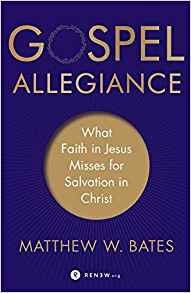Could it be that we’ve limited our definition of “faith” to our hopes and feelings? Could it be that by doing so we’ve limited our understanding of what the gospel is and what it calls us to?
Reading Gospel Allegiance
I’ll be the first to admit, this book is a little out of my wheelhouse. I likely wouldn’t have picked up a copy of Gospel Allegiance on my own, but when a free book shows up, you read it!
Note: This should not be taken as a request to send me more free books. But who am I to stop you?
In our world today, the word “gospel” has become shorthand for any truth that seems so apparent no one could miss it. In the church today, “gospel” is often a nebulous and smarmy word that defines everything from music to message, but far too often misses our mission. Add to that, the word “faith” has been relegated to the heart at the expense of the head, and Bates concludes, “we need better language and a new model to more accurately convey what Scripture teaches about salvation” (page 15).

A new model is necessary, and Gospel Allegiance seeks, not to redefine, but recapture the whole gospel in a way that makes the mission of Jesus and his church tangible, communicable, and whole.
Gospel Allegiance was not a difficult read, but it was one I needed to take slow and give plenty of time for review. Much coffee was consumed while reading this book. Give this one time to process and plan on returning to it often.
When we get the gospel right, our present life together enters into the eternal quality of life through discipleship.
page 17
A Book and a Conversation
One of the aspects I loved about this book is the tools that Bates includes for further study and edification. The first appendix is a “Gospel-Allegiance Summary.” I found myself referring to it often while reading and have returned to it a few times for further digestion.
The second appendix is a “Guide for Further Conversation” (why do I like that so much better than “Discussion Questions?”). The one thing I wish I had while going through the book was a group of friends to read it with. Hopefully, I can do that on the next time through.
A Unifying Book
It should not be surprising that a book focused on “allegiance” contains a solid call to unity among Christians. Bates himself is a living example of the unity he seeks in this book. On page 21 he declares himself a “theological mutt—a traditionally minded Christian who is pro-church but not associated with any particular denomination.” His experience and influence have moved him within Protestant, Catholic, and Orthodox circles with amazing acceptance.
In the face of seeking unity, though, Bates does a masterful job of taking to task some of the more well-known theologians of our day. John Piper and John MacArthur often find themselves in his sights through the book, along with a few other notable pop-theology gurus. Bates points are . . . well . . . pointed, but never lacking grace. That’s to be appreciated when a reader sees far too much of himself in those confronted by Bates.
All three great streams must mutually recognize one another as fully Christian. Lack of full communion at the Lord’s Supper between groups that uphold the one true gospel and share the Spirit is a scandal because it wrongly suggests that we are not fully brothers and sisters in Christ.
page 111
A Gospel of Works that Works
For me, the greatest benefit from Gospel Allegiance builds through the whole book and finally comes in chapter six, “How Works are Saving.” For everyone who has ever struggled with the place of deeds within a gospel of grace, Bates’s explanation will leave you convinced that these are not contradictions but expressions of allegiance that will motivate you to serve your Lord more—and seek others to do the same.
The only frustration I had with this portion of the book was I wanted it to come sooner; only to realize that he was building up to it and bringing me to a point where I could fully hear what he was saying.
Good works are saving when they are part of faith because the Holy Spirit empowers us to perform them.
page 189
Why Should a Preacher Read this Book?
My heart is for you preachers. You’ve got a limited amount of time to invest in reading and you desperately need something to help turn next week’s sow’s ear of a sermon into a silk purse. Is Gospel Allegiance worth the time? Absolutely!
I came away with some great illustrations I’ve tucked away, hopefully, to be used soon. There’s a great illustration in the introduction about Hiroo Onoda, the Japanese World War II officer who finally surrendered in 1974. Page 57’s illustration of flag-bearers in the Civil War is very inspirational.
Bates bases one chapter on John Barclay’s Paul and the Gift, distilling that large book down in ways that make it much more accessible to the person in the pew. I can see using that chapter as the basis for a sermon series titled “Six Dimensions of Grace.”
This is a useful book, though my notes to myself didn’t start until fifty pages in. Give this one time to catch you. Don’t feel intimidated by its reach or bad if you must take it slow. It holds together well and it’s a book you can easily come back to after a busy week of ministry.
Baptism reminds us that faith and bodily activity cannot be separated. Gospel allegiance helps us better understand why.
page 149
Pledge Your Allegiance
I’ve always loved the call to baptism in 1 Peter 3:21 as translated in the NIV. “This water symbolizes baptism that now saves you also—not the removal of dirt from the body but the pledge of a clear conscience toward God.” For many of us, we don’t hear the word “pledge” without making the mental jump to “of allegiance.” I’ve often presented baptism in these terms; you’re pledging yourself to Jesus’ kingdom, he’s pledging his care to you.
Gospel Allegiance puts heart, soul, and dirty, hard-working hands to that pledge. In the end, you’ll not find yourself standing and reciting, though. You’ll find yourself bowing in submission and rising in service.
Any gospel that makes discipleship optional or additional is a false gospel. Gospel allegiance helps us to understand why faith in Jesus, discipleship, and obedience to his commands go hand in hand.
page 224

